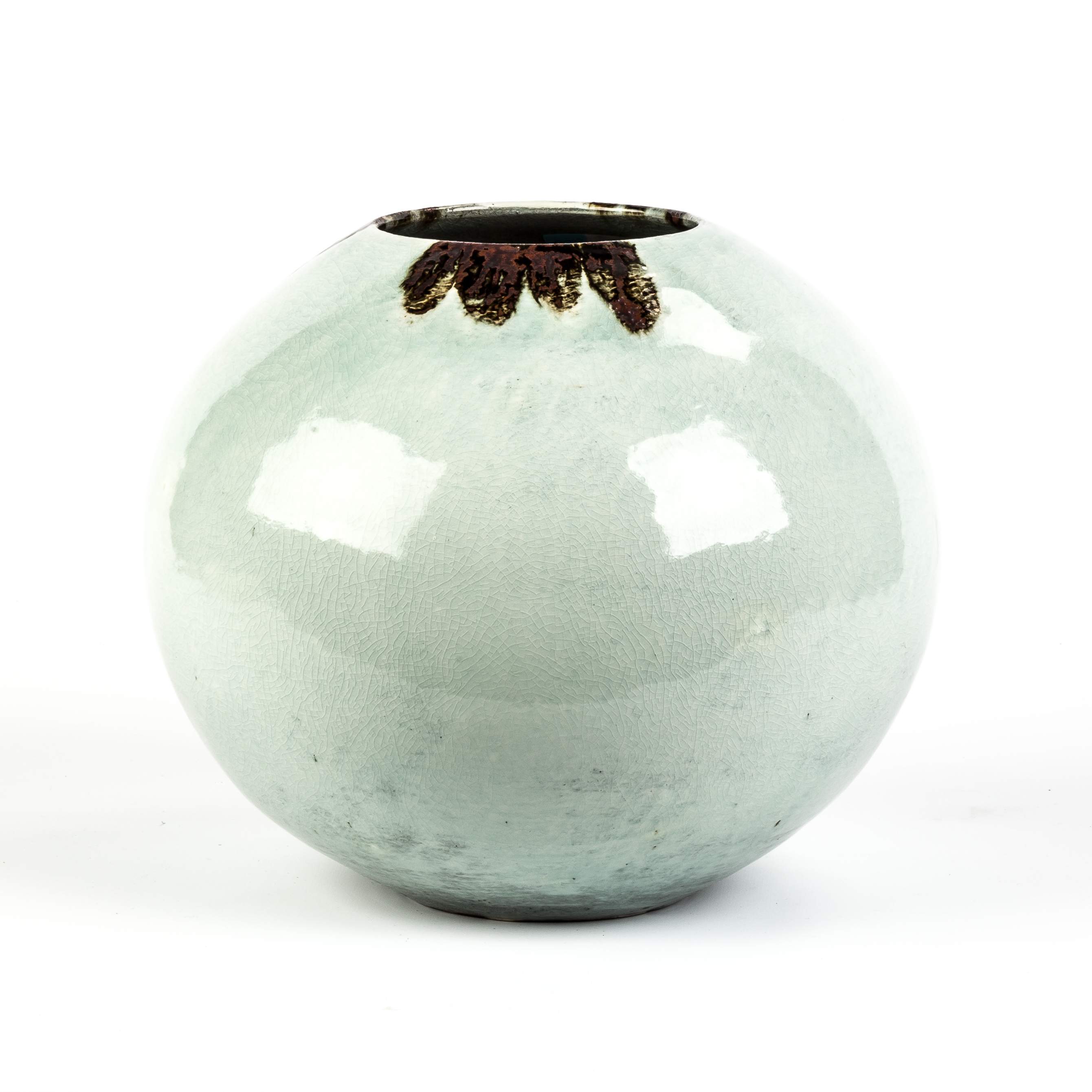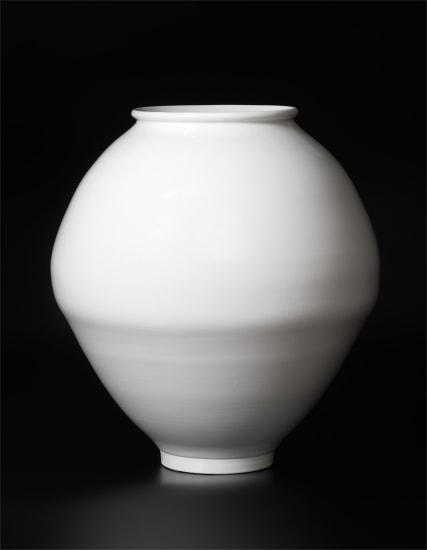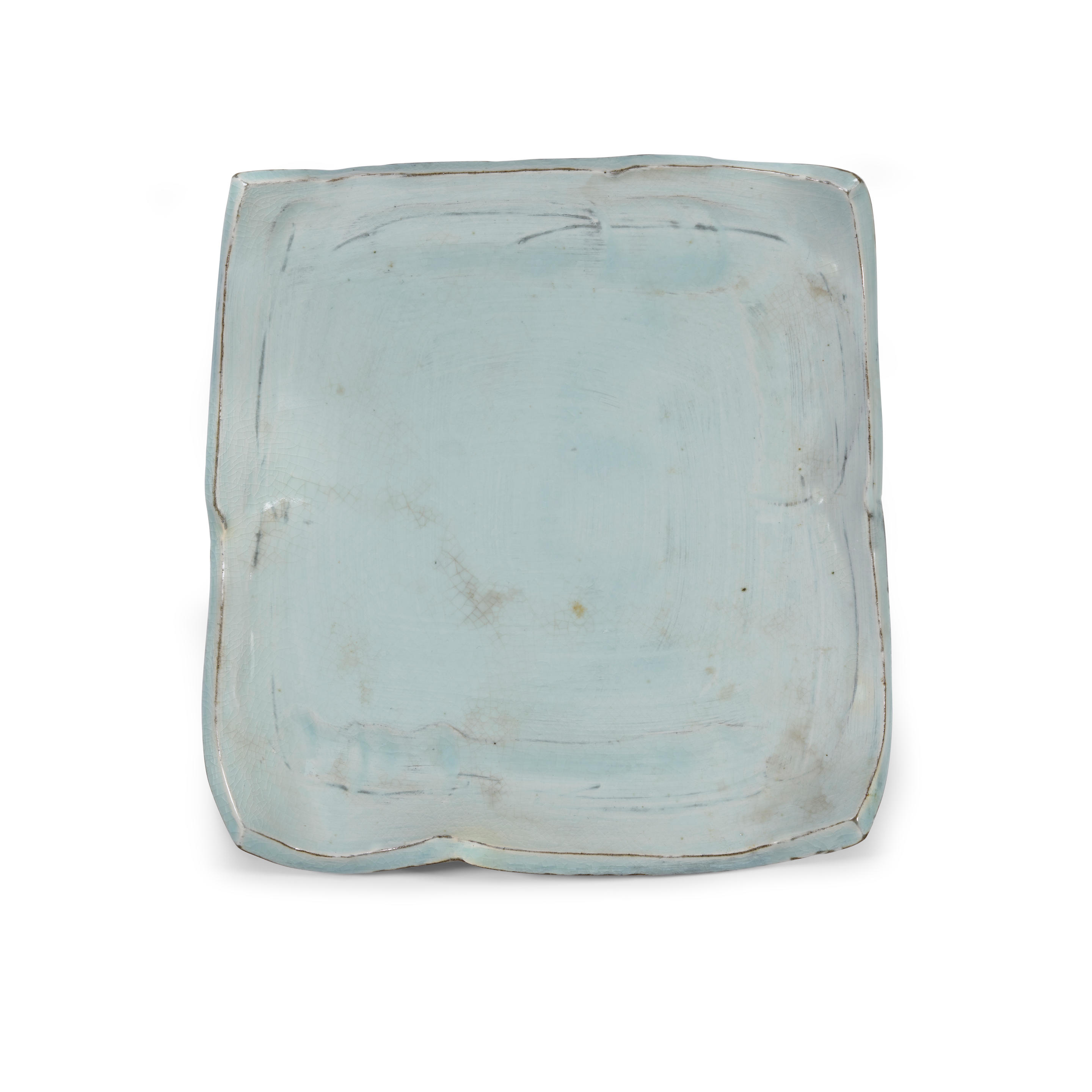Young Sook Park 'Moon Jar', no. 16 2007 Porcelain, white glaze. 65 cm (25 5/8 in.) high, 57.5 cm (22 5/8 in.) diameter Underside painted in Hangul with 2007 November 13th/A fragrance of plum blossom under the glaze.
Literature Park Young-Sook et al., Park Young-Sook's White Porcelain Moonjar, exh. cat., Show Gallery, New York and Gallery Hyundai, Seoul, 2006 Seizo Hayashiya, et al., Park Young Sook's White Porcelains, "Moon Jar" and Lee U Fan's Dishes, exh. cat., Musée Tomo, Minato, 2008 Fine Collection of raving beauty, New Vision Ceramic, Park Young Sook, exh. cat., RH Gallery, New York and Seoul, 2012 A World of Glowing White, The Porcelain Art of Park Young Sook, exh. cat., The Choi Sunu House, Seoul, 2015 Catalogue Essay "A perfect union happens when the top and the bottom surrender their individual selves and reach a compromise to exist forever as 'one'." - Young Sook Park The 'Moon Jar': a transcendent ceramic form Simon Olding Mrs Young Sook Park’s Moon Jar is a work of heft and a light-grace. It seems both to settle on its base, as well as float into a lunar arc. It is grounded and airy, with a contradictory resonance of stillness and motion. It is a pot of certainty and paradox. It is impossible, perhaps, for any contemporary Korean ceramic artist to represent the Moon Jar as a form without a deliberate acknowledgment of its complex, textured place in the country’s long ceramic history. This is both a national history, and also an international one, as the Moon Jar has fascinated many living makers, especially in the UK. The contemporary Moon Jar, whether made in Seoul by Young Sook Park or Adam Buick, working in rural Wales, will always consciously refer back to the early Korean exemplars. Moon Jars were originally made during the Joseon Dynasty (1392-1910). They are curvaceous, plain white porcelain jars, resembling a full moon. They were made customarily to contain flowers or wine; but they are also ritual, votive vessels. The finest historical examples date to the 18th century, and during the first half of the 18th century the Royal kilns at Gwangju, Gyeongyi province specialised in producing examples of exceptional quality, all made in a characteristic, milky-white porcelain. Moon Jars, due to their size, were made in two halves, joined together so that the line of the join is often visible. The line is visible in one remarkable example, purchased by Bernard Leach in Seoul in 1935 and bonded to Plymouth for customs examination in a consignment of ‘old Korean Pots’ that he gathered together for his personal collection. He described this work as a ‘very large white jar’ (18 ½ inches tall and 56 inches in circumference) with a value of 10 yen. Leach eventually asked Lucie Rie to look after the pot for him, and it remained in her Albion Mews studio throughout the Second World War - altogether for some fifty years, when she bequeathed it to Janet Leach. This Moon Jar stood quietly in a corner of Rie’s showroom, displayed as a counterpoint to her own modernist ceramics. Famously sold as the signature lot of ‘the Janet Leach collection’ in 1998, the Moon Jar was acquired by the British Museum. Following, it was commented that ‘Leach’s acquisition of this masterpiece is significant, for behind the apparent simplicity of colour and form, lies a complex philosophy and iconography, deeply rooted in Korea’s culture’. Leach’s Moon Jar played out a particular narrative: it represented the apogee of work by the anonymous craftsman and thus took its place in the pantheon of Korean ‘folk craft’; and it echoed the reticence of European modernism, such that its loan to Rie seemed inevitable. It may also have carried an emotional message: a gift to a deeply-loved friend. The Moon Jar’s public and museum life enabled it to become a lodestone for contemporary ceramic artists in the United Kingdom – notably Akiko Hirai and Adam Buick, and for a more limited period, Gareth Mason who has referred to its ‘haptic wisdom’. These makers presented examples of their ‘translations’ of the form in a major exhibition at the Korean Cultural Centre in 2013, framed by the British Museum’s Moon Jar. The show made explicit the tangible connection from the histo
Young Sook Park 'Moon Jar', no. 16 2007 Porcelain, white glaze. 65 cm (25 5/8 in.) high, 57.5 cm (22 5/8 in.) diameter Underside painted in Hangul with 2007 November 13th/A fragrance of plum blossom under the glaze.
Literature Park Young-Sook et al., Park Young-Sook's White Porcelain Moonjar, exh. cat., Show Gallery, New York and Gallery Hyundai, Seoul, 2006 Seizo Hayashiya, et al., Park Young Sook's White Porcelains, "Moon Jar" and Lee U Fan's Dishes, exh. cat., Musée Tomo, Minato, 2008 Fine Collection of raving beauty, New Vision Ceramic, Park Young Sook, exh. cat., RH Gallery, New York and Seoul, 2012 A World of Glowing White, The Porcelain Art of Park Young Sook, exh. cat., The Choi Sunu House, Seoul, 2015 Catalogue Essay "A perfect union happens when the top and the bottom surrender their individual selves and reach a compromise to exist forever as 'one'." - Young Sook Park The 'Moon Jar': a transcendent ceramic form Simon Olding Mrs Young Sook Park’s Moon Jar is a work of heft and a light-grace. It seems both to settle on its base, as well as float into a lunar arc. It is grounded and airy, with a contradictory resonance of stillness and motion. It is a pot of certainty and paradox. It is impossible, perhaps, for any contemporary Korean ceramic artist to represent the Moon Jar as a form without a deliberate acknowledgment of its complex, textured place in the country’s long ceramic history. This is both a national history, and also an international one, as the Moon Jar has fascinated many living makers, especially in the UK. The contemporary Moon Jar, whether made in Seoul by Young Sook Park or Adam Buick, working in rural Wales, will always consciously refer back to the early Korean exemplars. Moon Jars were originally made during the Joseon Dynasty (1392-1910). They are curvaceous, plain white porcelain jars, resembling a full moon. They were made customarily to contain flowers or wine; but they are also ritual, votive vessels. The finest historical examples date to the 18th century, and during the first half of the 18th century the Royal kilns at Gwangju, Gyeongyi province specialised in producing examples of exceptional quality, all made in a characteristic, milky-white porcelain. Moon Jars, due to their size, were made in two halves, joined together so that the line of the join is often visible. The line is visible in one remarkable example, purchased by Bernard Leach in Seoul in 1935 and bonded to Plymouth for customs examination in a consignment of ‘old Korean Pots’ that he gathered together for his personal collection. He described this work as a ‘very large white jar’ (18 ½ inches tall and 56 inches in circumference) with a value of 10 yen. Leach eventually asked Lucie Rie to look after the pot for him, and it remained in her Albion Mews studio throughout the Second World War - altogether for some fifty years, when she bequeathed it to Janet Leach. This Moon Jar stood quietly in a corner of Rie’s showroom, displayed as a counterpoint to her own modernist ceramics. Famously sold as the signature lot of ‘the Janet Leach collection’ in 1998, the Moon Jar was acquired by the British Museum. Following, it was commented that ‘Leach’s acquisition of this masterpiece is significant, for behind the apparent simplicity of colour and form, lies a complex philosophy and iconography, deeply rooted in Korea’s culture’. Leach’s Moon Jar played out a particular narrative: it represented the apogee of work by the anonymous craftsman and thus took its place in the pantheon of Korean ‘folk craft’; and it echoed the reticence of European modernism, such that its loan to Rie seemed inevitable. It may also have carried an emotional message: a gift to a deeply-loved friend. The Moon Jar’s public and museum life enabled it to become a lodestone for contemporary ceramic artists in the United Kingdom – notably Akiko Hirai and Adam Buick, and for a more limited period, Gareth Mason who has referred to its ‘haptic wisdom’. These makers presented examples of their ‘translations’ of the form in a major exhibition at the Korean Cultural Centre in 2013, framed by the British Museum’s Moon Jar. The show made explicit the tangible connection from the histo





.jpg)

.jpg)
.jpg)






Try LotSearch and its premium features for 7 days - without any costs!
Be notified automatically about new items in upcoming auctions.
Create an alert